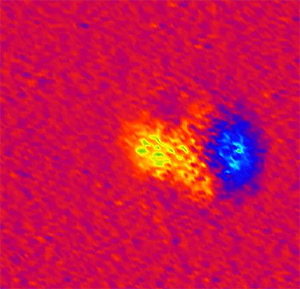Fluorescent nanodiamonds are useful little particles, providing an unblinking glow that resists photobleaching. They are biologically inert, lending themselves to a range of medical applications. But what are they, really?
They begin in a laboratory, rather than in a mine. The most common methods used in their creation are chemical vapor deposition and explosive detonation of TNT; although many research groups are investigating other ways to create the tiny gems. 
A nano-size diamond fluoresces brightly. (Image: F. Jelezko and G. Balasubramanian, Physics Institute, Stuttgart, Germany)
Although they possess many of the same qualities as natural diamonds – a hard but brittle structure, a carbon base and similar optical properties – the manmade stones are not identical to their brethren. Laboratory-created diamonds are typically yellow, due to the presence of substitutional nitrogen, and once they are processed to fluoresce they usually appear pink or purple.
Red and green fluorescence is created by bombarding the nanodiamonds with high-energy electrons, which cause the nitrogen to form gaps in the lattice-like structure of the crystal. The stones are then exposed to high temperatures in a process called annealing, which traps the nitrogen “bubbles” in place. When excited by specific wavelengths, these bubbles will fluoresce.
In March, researchers from Drexel University in Philadelphia discovered a mechanism by which nanodiamonds can be made to fluoresce blue. Rather than use electron bombardment, they bound octadecylamine – a common ingredient in hydrophobic compounds – to the surface of the gems. The scientists are currently investigating the mechanism by which the altered stones shine blue under UV light.
Despite their many useful attributes, however, fluorescent nanodiamonds are not widely used in research settings. The main obstacle to their adoption thus far has been the difficulty and expense involved in producing particles with consistent properties - amorphization and the loss of moving vacancies to the surface of the diamond during processing greatly reduce the efficiency and yield of traditional creation methods.
Researchers in Europe have created a new method for producing fluorescent nanodiamonds, which may make them more appealing for use in laboratory settings. For more information, see “A cheaper path to nanodiamonds” in the August issue of Photonics Spectra.
Rebecca C. Jernigan
[email protected]